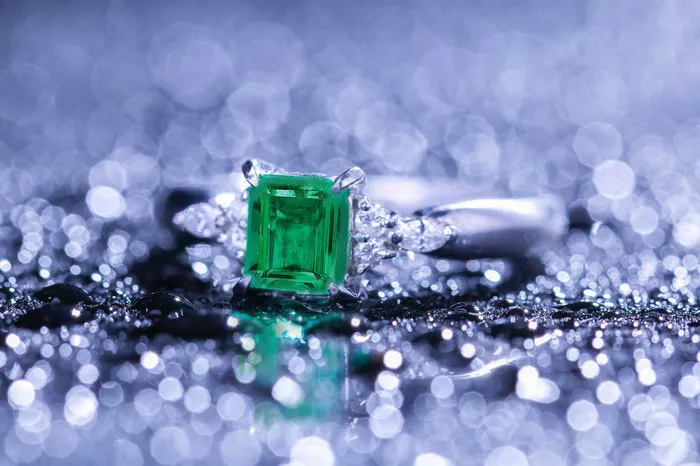Yellow emeralds, also known as heliodor, are a variety of the mineral beryl that exhibit a beautiful golden-yellow color. While not as famous as their green counterparts, yellow emeralds are still highly sought after by gem collectors and jewelry enthusiasts alike. In this article, we’ll explore the fascinating world of yellow emeralds, delving into their composition, color origin, and how they compare to other beryls.
The Beryl Family
Yellow emeralds belong to the beryl family, which includes several well-known gems such as emerald, aquamarine, morganite, and heliodor. Beryl is a cyclosilicate mineral with the chemical formula Be3Al2(SiO3)6. It crystallizes in the hexagonal crystal system and typically forms prismatic crystals.
One of the defining characteristics of beryl is its hardness, which ranges from 7.5 to 8 on the Mohs scale. This makes beryl a relatively durable gemstone, suitable for everyday wear in jewelry. The beryl family is also known for its wide range of colors, which are often caused by the presence of trace elements in the crystal structure.
The Color of Yellow Emeralds
The golden-yellow color of heliodor is caused by the presence of iron (Fe) in the beryl crystal structure. When iron substitutes for aluminum in the beryl’s lattice, it creates a color center that absorbs blue and violet light, resulting in the yellow hue we see.
The intensity of the yellow color can vary depending on the amount of iron present and how it is distributed within the crystal. Some yellow emeralds may have a more intense, vivid color, while others may appear paler and more lemon-like.
Distinguishing Yellow Emeralds from Other Beryls
While yellow emeralds are a type of beryl, they can be distinguished from other beryl varieties by their color and sometimes their inclusions. Here’s how yellow emeralds compare to some of the most well-known beryl gems:
1. Emerald: Emeralds are the most famous and valuable variety of beryl, known for their rich green color caused by the presence of chromium and sometimes vanadium. Yellow emeralds are much less common and valuable than their green counterparts.
2. Aquamarine: Aquamarine is a blue to blue-green variety of beryl, colored by the presence of iron. Yellow emeralds can be distinguished from aquamarine by their golden-yellow hue and the absence of blue or green tones.
3. Morganite: Morganite is a pink to peach-colored variety of beryl, colored by the presence of manganese. Yellow emeralds are easily distinguished from morganite by their yellow color and the absence of pink or peach tones.
4. Goshenite: Goshenite is a colorless variety of beryl. While yellow emeralds and goshenite are both beryls, goshenite lacks the distinctive golden-yellow color of heliodor.
Inclusions in Yellow Emeralds
Like other beryls, yellow emeralds can contain various inclusions that can be used to identify them and sometimes determine their origin. Some common inclusions found in yellow emeralds include:
1. Two-phase inclusions: These inclusions consist of a liquid and a gas bubble trapped within the crystal. They are often used to identify natural yellow emeralds.
2. Fingerprints: These are clusters of tiny fluid inclusions that resemble fingerprints. They are common in natural yellow emeralds and can help distinguish them from synthetic stones.
3. Needles: Thin, needle-like inclusions are often found in yellow emeralds. They are typically composed of rutile or hematite.
4. Mica flakes: Thin, flat inclusions of mica minerals can sometimes be found in yellow emeralds.
See Also: The Incomparable Value of Yellow Emeralds
Sources of Yellow Emeralds
Yellow emeralds are found in various locations around the world, but some of the most well-known sources include:
1. Brazil: Brazil is one of the largest producers of yellow emeralds, with deposits found in the states of Minas Gerais and Bahia.
2. Afghanistan: Afghanistan is known for its high-quality yellow emeralds, particularly from the Panjshir Valley.
3. Russia: Russia, particularly the Ural Mountains, is another important source of yellow emeralds.
4. United States: Yellow emeralds have been found in the United States, notably in California and Colorado.
Synthetic Yellow Emeralds
In addition to natural yellow emeralds, there are also synthetic versions available on the market. Synthetic yellow emeralds are created in laboratories using techniques such as hydrothermal growth or flux growth. While they have the same chemical composition and physical properties as natural yellow emeralds, synthetic stones are typically less valuable and can be distinguished from natural stones using advanced gemological testing methods.
Caring for Yellow Emeralds
Like other beryls, yellow emeralds require some care to maintain their beauty. Here are some tips for caring for your yellow emerald jewelry:
1. Avoid harsh chemicals: Chemicals such as chlorine, acids, and abrasives can damage the surface of yellow emeralds. Remove jewelry before swimming or using household cleaners.
2. Clean gently: Use a soft brush and mild soap and water to clean yellow emeralds. Avoid ultrasonic cleaners, which can cause inclusions to expand and damage the stone.
3. Store carefully: Store yellow emerald jewelry separately from other jewelry to prevent scratches. Use a soft cloth or jewelry box to protect the stones.
4. Consider repolishing: Over time, the surface of yellow emeralds may become dull or scratched. Consider having the stones repolished by a professional gemologist to restore their shine.
Conclusion
Yellow emeralds, or heliodors, are a fascinating and beautiful variety of beryl that deserve more attention from gem enthusiasts. With their golden-yellow color and unique inclusions, yellow emeralds offer a distinctive alternative to the more well-known green emeralds and other beryl gems. Whether you’re a collector or simply appreciate the beauty of natural gemstones, yellow emeralds are definitely worth exploring.


